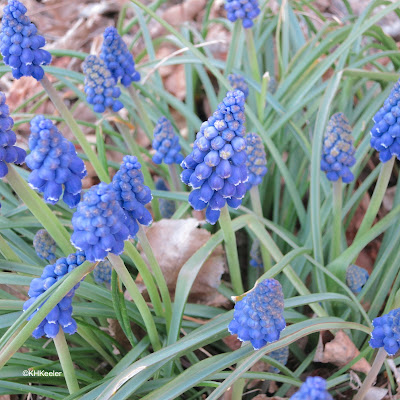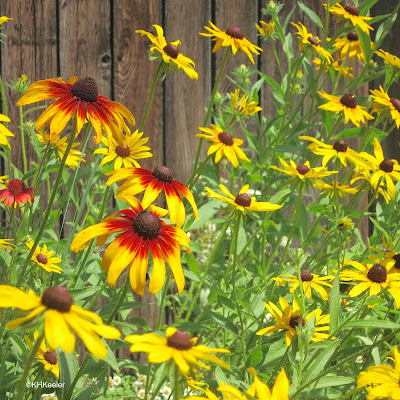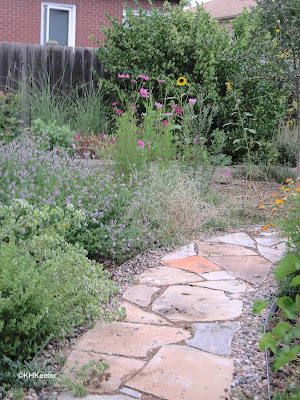As I wrote two weeks ago (link), I'm trying to support birds by growing plants that produce insects for them to eat. The evidence is strong that native plants will support the insects that live around us and that most exotic plants will not.
BUT, to feature native plants in my yard, I have to know what plants are native. Or, alternatively, know which of the plants in my yard are not native. That is suprisingly hard.
There are good online references for finding out which plants are native. You can look at Wikipedia or Missouri Plant Finder (link) or other sites, many say where plants originated. Or, you can look in a regional flora, Flora of Colorado in my case, to see what it says (Flora of Colorado notes whether plants are introduced, it doesn't actually say which are native.)
However, to use those resources, you have to have a name for the plant. That isn't always easy, either. My yard came with lots of plants whose name I really don't know. I have always been happy with a general (genus-level) name, like larkspur and maple, and didn't worry whether it was plains larkspur or rocket larkspur, silver maple or red maple.
 |
| larkspur, Delphinium |
Sometimes a general name is enough. I have grape hyacinths. They are genus Muscari and all the Muscari species are Eurasian. OK, cool but not native.
 |
| grape hyacinth, Muscari species |
Identifying an unknown cultivated plant to species can be difficult. Identification books do not generally include garden plants. Online sources like the Facebook page Plant Identification (link) and the iNaturalist website (link) are helping with that.
A third plant in my garden is a tall, white-flowerded phlox. The genus Phlox, according to Wikipedia, is mostly North American.
 |
| phlox, genus Phlox |
That brings up the question: what do I mean by native? A plant native somewhere else in North America may not help my local food chain. The coasts have many plant groups not well-represented in Colorado that Colorado insects probably cannot eat. Some days I look at the Flora of Colorado and plan to grow only plants that occur naturally in my county, a very narrow definition of native. Other days I want regional natives, especially since global warming is bringing New Mexico to me. But I don't count a plant found only in California as native where I live.
What phlox is it? I don't yet know.
Sometimes I can determine if my plant is native without actually naming it. I have a maple tree. Maples are the genus Acer. Wikipedia says there are "There are approximately 132 species, most of which are native to Asia, with a number also appearing in Europe, northern Africa, and North America." Looking at The Flora of Colorado, there are only two plants in the genus Acer native to my county. One is a shrub--the tree in my back yard is much bigger than that. The other native "maple" is Acer negundo, the box elder, a tree I can recognize and which is not the maple in my yard. Conclusion: the maple is at least slightly exotic.
As a first response to encouraging plants that support insects that feed birds, though, what I really want are plants that local insetcts will eat. They don't have to be native. Members of groups (plant species, genera, and families) not common in the United States or that are toxic are unlikely to be good food for American insects. English ivy, Hedera helix, for example, is slightly poisonous. Compared to England, very very few insects eat it in North America. It is in the plant family Araliaceae, and there are only two species in that family in Colorado, both at high elevations. (More about English ivy link). Not a good base for my food chain.
Widespread groups with numerous North American species are better choices. For example, dill (Anethum graveolens) is a European herb in the family Apiaceae. There are 69 species in that family native to Colorado. Black swallowtail butterfly caterpillars (Papilio polyxenes) and their relates are famous for consuming dill. Obviously dill is close enough to their native host plants.
 |
| apple tree, beautiful, useful, and non-native |
I have pointed to the difficulties here, but the origin of most plants are easy to work out. The peonies, apple trees, apricot trees, daffodils, dandelions, tulips, hyacinths, crocuses, and lilacs are not native. The Colorado blue spruce, junipers, snowberry, creeping hollygrape, columbines, blanket flower, cone flowers, and little bluestem are native to Colorado.
In terms of joining Homegrown National Park (link) and providing food for native animals, even though I don't have all the plants worked out, I can see some that should be encouraged and others that I won't replace when they die.
 |
| Natives are beautiful! Blanket flower (Gaillardia species) and black-eyed Susans (Rudbeckia hirta). |
Figuring out which of my plants will help wildlife is a necessary first step. I don't have to work it all out or get it completely right before I can act. I'll plant more columbines and blanket flowers! Easy!
Comments and corrections welcome.
ReferencesAckerfield, j. 2015. Flora of Colorado. BRIT Press. Fort Worth, Texas.
Missouri Botanical Gardens. Missouri Plant Finder. link
Tallamy, D. W. Homegrown National Park. See his website: link
Kathy Keeler, A Wandering Botanist
More at awanderingbotanist.com
Join me on Facebook: https://www.facebook.com/AWanderingBotanist

No comments:
Post a Comment